- HOME
- BEST POKER TRAINING SITES
- POKER GUIDES
- ONLINE POKER ROOMS GUIDE
- POKER NOTES LIVE APP
- MORE
Before diving deeper into reviewing Upswing Poker’s Advanced PLO Mastery, a little context. While the game of No Limit Texas Hold’em is definitely the number one choice of most players, certain other variants of the game have been gaining in popularity as of late. This is especially true for Pot Limit Omaha, a game that offers a lot of action and provides a solid edge for those who actually take time to study proven underlying strategies.
If you want to learn to play Hold’em, you’ll find heaps of resources out there, both paid and free, and you’ll have no problems quickly advancing your skills. When it comes to PLO, though, resources aren’t nearly as available, especially for players who already have decent fundamentals and are now looking to take things to the next level.
If you belong to the aforementioned group, the latest course from Upswing Poker is probably the best answer to your query. Entitled Advanced PLO Mastery, this course will help you learn all you need to know about the game, from opening ranges to firing multi-street bluffs (and everything in between). The course is focused on 6-max cash games but lessons can be applied to other formats as well.
Created by Chris Wehner and Dylan Weisman, the Advanced PLO Mastery course is a comprehensive, well-organized strategy guide that covers every area of the game. Like the title suggest, this is an advanced course, so it is primarily intended for those already familiar with Pot Limit Omaha. Naturally, it can work for total novices as well, provided you’re willing to put in the required time and effort.
Advanced PLO Mastery is split into several main groups. The best way to go about learning skills and strategies explained in the course is to watch the videos in the order they’re presented, without skipping around too much. Both Weisman and Wehner have done their best to make the course’s progression feel as natural as possible, so as long as you stick with the program, you should have no problem keeping up. The course’s 8 modules are:
While many players might be inclined to just skip the Intro section and move straight to the actual lessons, I’d suggest watching the first few videos. In them, the course creators explain everything you need to know to better keep up with presented materials. In other words, it’s best to slowly use the steps to walk into the pool rather than jump right in to the deep end.
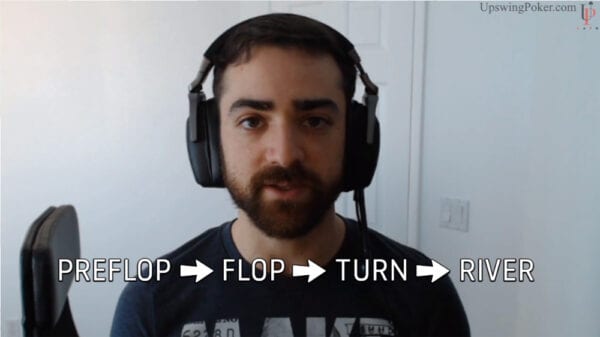
In the Intro, you’ll learn about the tools used throughout the lessons, what kind of system the instructors use to describe the hands, and, most importantly, how to make most out of the knowledge contained within.
Every strategy section also contains short quizzes, which can be very useful to check your newly acquired knowledge and see if you’ve managed to properly absorb and internalize the concepts that were discussed. While these quizzes aren’t particularly long and only contain a few questions each, taking a few minutes to go through them will definitely help you quickly discover if there is something you missed or didn’t understand properly.
The short answer to this question would be – everything! Upswing Poker’s Advanced PLO Mastery is probably the most comprehensive PLO course in existence right now and if you want to raise your game to the next level, you’ll find all the tools you need to do so inside.
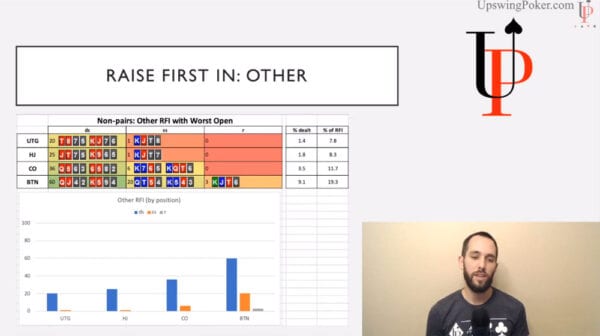
The Pre-flop section offers a step-by-step guide to creating your pre-flop ranges and teaches you how to decide what hands to play and what hands to avoid. If you’re just making a transition to Pot Limit Omaha, this section will really help you understand how your starting hand selection is vital to everything that happens later in the hand. With so many starting hand combos, figuring all this out is much harder than in Hold’em, but after watching these videos, you’ll know exactly how to go about it.
The other three strategy sections cover respective streets, i.e., flop, turn, and river. Each of them contains hours’ worth of video lessons as well as some specific charts you can use.
Worth noting is that things do get increasingly complicated as you progress through the course. This is not a course you can just zip through easily without paying close attention. A majority of strategy explained in the videos is based on the calculations done using MonkerSolver, the top tool for finding GTO solutions for pretty much any scenario you can think of.
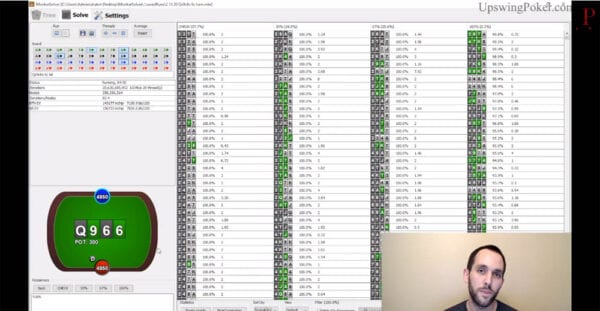
What this means is that you’ll have to deal with a lot of numbers and stats. Wehner, who was mostly in charge of doing Monker calculations, tries to explain every spot he talks about using numbers and examples from the software. So, to really get your money’s worth, you’ll need to focus and give these videos your full attention. Otherwise, you might find yourself completely lost halfway through the video. I know that while plowing through the course, I myself had to re-watch a few sections in order to fully understand.
The final three sections of the Advanced PLO Mastery course really add a lot of value to an already top-quality product. Videos in Centralized Spotlights focus on several particular areas of the game and give them more attention even if they were discussed earlier in the course. You’ll learn more about some common pre-flop mistakes, warped ways of thinking about the game, and even some MTT-specific strategies.

In the Professional Fundamentals section, Weisman talks about things that every poker player needs to know, regardless of their choice of game. Learning how to handle tilt, deal with downswings, and balance things out between your professional and private life is key to success, which makes these videos a really nice and extremely valuable addition to the course. Plainly speaking, it also gives your brain a welcome break from the hard core math you’ll be encountering.
Finally, the Play & Explains section features hours’ worth of videos of Chris Wehner dissecting his own high stakes PLO hands played against some of the game’s best, like Phil Galfond. These are a great watch in their own right but of course you’ll get much more out of them if you watch them once you’ve actually completed the strategic part of the Advanced PLO Mastery course. As mentioned above, the course’s progression is natural and you don’t want to be skipping around.

Proving dedication to their members, Upswing has updated the Advanced PLO Mastery course since the launch, adding more content to the hand review section. New videos feature Chris Wehner analyzing live play sessions by two site members, Ben and Pierce. These videos do require quite a bit of focus to watch as Wehner tries his best to keep up with the action on four tables, but are a very valuable addition to the Advanced PLO Mastery course.
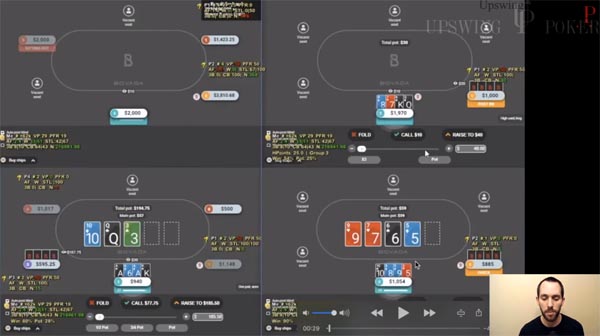
If you love Pot Limit Omaha and want to take it seriously, there is no other course like this out there on the market. If you go through all the lessons and actually take time to contemplate and process the knowledge presented, you’ll be ready to play at a very high level. This is a top quality poker course presented by instructors who have the results to back up what they’re teaching.
The only caveat to be mindful of is that Advanced PLO Mastery will only actually make you a better player if you’re willing to invest time and effort. This course demands a lot of its students, and you’ll need to think and study hard to follow its guidelines if you want to make most out of it. As long as you don’t have a problem with “going back to school” for a little while, though, Upswing Poker’s Advanced PLO Mastery will easily result in you recouping your investment many times over.
The crew reflects on RecPoker Day at Running Aces on February 29, 2019, including picking Rob’s brain on his two deep runs that day. We include a sample of interviews conducted on RecPoker Day as well as the expansion of RecPoker through new programs and our first official ambassador, Josh Schwartz in Colorado. We also look at a hand history from Shayan Bhattacharyya where the panel all have some different perspectives on the approach to the hand.
Check out the RecPoker Train and Connect page for information on joining our membership site or discord channels. The RecPoker Home Game page has all the info to join in our home games on the first and second Wednesdays of each month.
| 0:00 | Welcome & Introduction |
| 1:45 | Listener Question from Shayan |
| 25:02 | Rob’s Deep Runs on RecPoker Day |
| 41:47 | RecPoker Day Recap and Interviews |
| 52:50 | RecPoker Ambassador in Colorado |
| 56:25 | New Opportunities for Coaching, Home Games, and Bar Leagues |
| 1:00:21 | Running Aces Player of the Week and Binks |
| 1:02:03 | Other Announcements |

In this episode of The Bernard Lee Poker Show, Bernard Lee first welcomes Steve Fredlund and his RecPoker podcast to the Cardplayer Lifestyle Podcast Family. Then, Bernard interviews Jake Daniels, who has recently earned almost $500,000 in the past few months, including victories in an Aria High Roller victory last week and a WPT preliminary event in December 2019. Bernard and Jake discuss how he has improved his game to play in some of the biggest buy-in tournaments in the world.
| 0:00 | Welcome to The Bernard Lee Poker Show as this week’s guest will be Jake Daniels. |
| 0:58 | Bernard welcomes Steve Fredlund to the Cardplayer Lifestyle Podcast Family and they discuss his podcast, RecPoker, which focuses on strategy for the amateur poker players and on the poker community. |
| 10:26 | Joe Walters captures the RunGood Poker Series at the Jamul Casino in the San Diego area, outlasting a 294-entry field and earning 31,280. |
| 11:43 | Eric Afriat wins his third WPT Main Event title as he takes home almost $380,000 from the WPT Fallsview Poker Classic over a 594 player field. He becomes the sixth player ever to win three WPT Main Event titles. |
| 13:42 | WSOP Circuit is finishing up in Las Vegas at the Rio All-Suite Hotel and Casino. The results will be discussed next week. |
| 16:33 | RunGood Gear Ad |
| 17:15 | Share My Pair Ad |
| 17:48 | Bernard welcomes Jake Daniels to the show. |
| 18:53 | Jake joins the show. |
| 19:54 | Jake discusses his recent success and what he has recently done to improve his poker game, including working on his post-flop play. |
| 24:25 | Jake discusses putting maximum pressure on players and recalls a critical hand in the 2019 WSOP Main Event. |
| 28:42 | Jake discusses tightening up his pre-flop range. |
| 31:17 | Jake explains why he is transitioning over to larger buy-in events. |
| 42:07 | Jake discusses his company that he owns and his 2020 WSOP schedule. |
| 44:28 | Jake discusses his schedule prior to 2020 WSOP which includes the U.S. Poker Open and EPT Monaco. |
| 45:42 | Jake recalls his first $25,000 buy-in at partypoker Millions in Uruguay. He finished 3rd for $150,000, while his roommate James Romero captured the title for $325,000. |
Although it was previously considered a bad play in general (hence the name), donk betting has earned its place in modern poker strategy.
People will no longer look at you as if you had lost your mind when you bet into the original raiser on the flop. Nowadays, it is considered legitimate in both live play and on online poker sites.
However, even if donk betting has found its way out of poker’s doghouse, it’s still not a standard play by any stretch of the imagination. It is – and will always likely be – more of an unusual line that you’ll want to take now and again. So, with that in mind, here are the top 3 things to consider when looking to utilize the donk betting tactic.
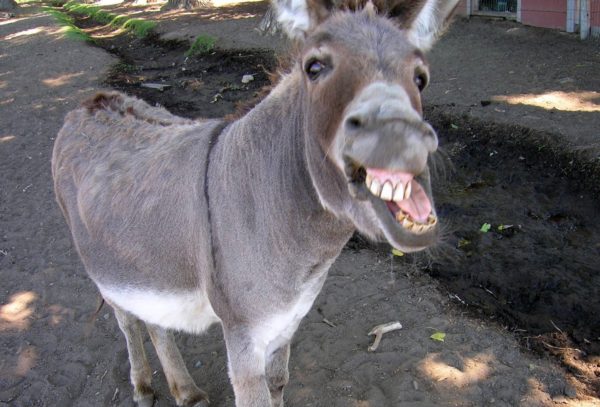
When you find yourself in a scenario where you have a clear range advantage over the pre-flop aggressor, donk betting can be a valid strategy. On certain board textures, your range of hands will simply be ahead of your opponent’s by a fair margin. When this happens, you might want to consider a donk bet.
The reason for this is that your opponent probably knows they’re behind your range. If you check to them, they will frequently check behind and take the free card to try and improve. By using donk bet, you deny them the opportunity and make it harder for them to continue in these spots.
This isn’t to say that you should always donk bet in these situations as that will make you very exploitable. Instead, pick your spots with some strong hands and a few bluffs and use them as donk bets instead of check-folds or check-raises.
The biggest reason why donk betting isn’t more popular among players isn’t that it’s inherently bad, but rather because it’s very hard to build your donk betting range in a balanced way. It takes a lot of studying and memorizing things to learn an effective donk betting strategy.
If you can’t have a well-balanced range, you’re probably better off not having one at all. You can’t simply “decide to donk bet strong hands” (strategically speaking) since this will change how you need to play your entire range. I have even heard players saying that they face more poker coolers in such situations, but I doubt it can have anything to do with donk betting.

If you feel like other aspects of your game are very strong, and there isn’t much room for improvement, focusing on donk betting can be valuable. However, if you feel like there are still other areas where your game is lacking, you should definitely focus on those first (be it c-betting, playing in 3-bet pots, or whatever else which comes more often and is more important).
This is because even with the perfectly balanced donk betting strategy, you still won’t gain that much of an edge over your opponents, especially at the higher stakes. There is simply a limit to the effectiveness of the donk bet that you won’t be able to break, which brings me to my final point.
Even if donk betting is no longer seen as something that only bad players do, it’s not something you absolutely must-have in your playbook, just because it is hard to execute correctly.
Firing a donk bet every now and then to surprise your opponents and get them out of their comfort zone can be a good thing, but it’s not required for your success.

You could spend your entire poker career playing “standard” without integrating donk betting into your overall strategy and still have great results. So, you shouldn’t obsess over learning the optimal donk betting strategy or try to force it into your game. If you don’t have time to study it properly or don’t feel comfortable using it, just don’t. You won’t be leaving heaps of money on the table, and that’s a promise.
Experimenting with different plays can be good for your development as a poker player, so don’t be afraid to give this advice a try. But don’t let anyone tell you that donk betting is something you have to, because it’s probably not.
Once you stop learning, you start dying.
These are the oft-quoted words of Albert Einstein (1879 – 1955), probably one of the most brilliant men who ever lived.
The German-American physicist is undoubtedly best known for his Theory of Relativity. Among his many awards and recognitions, he also earned the Nobel Prize for Physics in 1921 for his explanation of the photoelectric effect, and numerous other awards and honors. In 1999, Time magazine named Albert Einstein their Person of the Century.

Incidentally, Einstein was also among the first to warn of the dangers from the Nazis as they grew in power in Germany and Europe. He was fortunately able to escape in 1933.
Is there any doubt that there is much to learn if you want to be a winning poker player? Just scratching the surface, there’s the importance of:
Of course, there are so many other poker strategies and tactics as well. Whether you’re a recreational poker player and fan of the onlinecasinos.net live dealers games or a semi pro who prefers to play poker in brick and mortar casinos, there’s always so much to learn about the game! It could take a lifetime to learn them all. Heck, I’m in my nineties and I’m still learning!
So, let’s follow the advice of Albert Einstein: Keep learning. Never give up. “Never stop learning!”
First of all, recognize that it takes self-control to stick to the task. You can’t be learning much about winning poker strategies if you are watching the sporting event being shown on the large TV screens up on the wall. Focus is essential. Concentrate on the poker game. Eating your lunch as you play is not the way to best learn. Take a lunch break from the game.
Learn from observing and assessing your opponents’ actions. Would you have played it differently? Why?
Learn how to minimize losses; better to fold that hand as early as possible. It’s no sin. Second-best can be very costly.
There are literally hundreds of poker books available. As you read them at home, take notes and ponder their messages. Periodically review your notes. What does each mean? How and why will it help you to be a winner – better yet, a BIGGER winner. For example, if you learn when best to value bet, you can win so much more at the poker table!
Magazine articles and poker blogs are also great sources for learning. Take advantage of those that are available that offer worthwhile lessons, strategies, and tips. Why spend your valuable spare time reading about individual players and all the money they won in a big tournament?
Discussions with poker buddies can help, too. Talk over a hand you observed. How was it played? Is there a better way?
It’s wise to take an occasional break from the game. Go outdoors for a brisk walk in the fresh air; clear your mind. Think about how you played some of those hands. Could you have done a better job?
I trust the wisdom of Albert Einstein: “Once you stop learning, you start dying.” You can avoid “dying” at the poker table. It’s up to you.
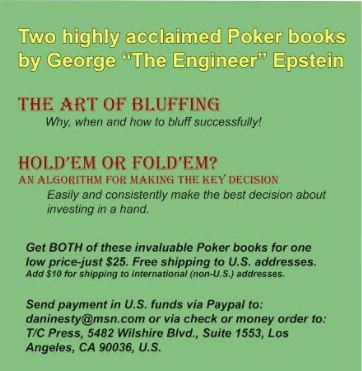
The crew chats with the fantastic Maria Ho including a brief discussion of her big fold with a set of tens during the 2017 World Series of Poker Europe Main Event. Make sure to follow Maria on Twitter and pretty much everywhere else!
We also announce our new partnership with the Cardplayer Lifestyle family of podcasts, whose member shows include the Top Pair Home Game Poker Podcast, the Bernard Lee Poker Show, and now the RecPoker Podcast. From now on recaps + timestamps of the show will appear on this site, as you see below. We hope you enjoy watching and listening to our show, which you can find embedded below.
We encourage all our listeners, as well as fans of Cardplayer Lifestyle to check out this page for information on joining our membership site or Discord channels. Finally, our Rec Poker homepage has all the information you need to join in our home games, which take place on the first and second Wednesdays of each month.
| 0:00 | Welcome & Introduction |
| 0:30 | Meet Maria Ho |
| 5:38 | Listener Questions with Maria |
| 17:55 | Strategy Discussion with Maria |
| 34:23 | Reflections on Interview |
| 36:16 | Big Announcement: Joining Cardplayer Lifestyle Family of Podcasts |
| 38:48 | Running Aces Player of the Week and Binks |
| 41:40 | Other Announcements (“RecPoker Day at Running Aces” and more!) |

I’d like to start this with a confession. I wanted to like this book, but I was prepared to have to sugarcoat my review of it.
The good news is that I don’t have to sugarcoat anything. Amanda Botfeld’s A Girl’s Guide to Poker is a fabulous book! It makes me want to go to a local casino and play poker. And those who know me understand what a rarity this is.
I’ve been writing about the poker biz (everything but strategy, obviously) for about 15 years. At the end of any work day, after reading and writing about poker, the last thing I want to do is play poker.
A Girl’s Guide to Poker is anything but your average poker book. It is not dry, long, or difficult to read. It is also not boastful or condescending in any way. Rather, it feels like a friend jotted down some notes – some very detailed notes – to help me fall in love with a game that she already loves.
After spending 15 years trying to convince men in poker to call us women, not girls, I wondered why a well-educated woman would market her book as a “girl’s guide.”
As it turns out, Botfeld penned the book as if talking to friends. She explains in an early chapter, “This book is the cool, chic, poker-playing friend you’ve always wanted.” And as any good girlfriend knows, girls can call each other girls.
The first sections of the book explain Botfeld’s journey to poker, from her dad’s love of the game to her first adventures at the tables. I immediately related to her difficulties with math, her trouble with dense poker books, and her desire to break it all down. Add in that she was a research associate working in Washington D.C. and went on to write about politics, and I knew that she was a girl – woman – after my own heart.
About two dozen pages into the book, Botfeld explains why the key to good poker is storytelling. “Telling a coherent story is how you play the game instead of how you play your cards.”
Evidently, this also pertains to writing a good poker book. What Botfeld successfully does in her book is to tell a story. She weaves her personal story in with the narrative about how to become a poker player, and she does so by strategically placing facts and figures in with her unique voice. She uses humor and anecdotes but also manages to get right to the point in every chapter.
NEW: A Girl’s Guide to Poker author @amandabotfeld knows what it’s like to be the only girl in a poker room playing mid-stakes cash games.
In this post, Amanda shares her experiences, and calls out for other girls to join her at the poker tables.https://t.co/00QuZHdPjD
— Robbie Strazynski (@cardplayerlife) January 12, 2020
Her book is also a solidly formatted story. She starts with a “Where to Start” section, logically, and takes players through everything from the very basics – what is that button for? – to poker jargon to explanations of position power and bet sizing.
The layout of A Girl’s Guide to Poker is perfect for her target audience. The book is 8” x 6” and barely 200 pages. Nearly every page of it includes illustrative photos and/or specially-framed points. There are red boxes with special messages to highlight key information, and there are pink circles containing “pro tips.”
For example:
“Pro tip: Remember the three deal breakers: blinds, competition, rake. If a poker game isn’t good to you in these three categories, stand your ground! A bad game is fine for a fling, but you won’t be able to build a solid future.”
Red box: “Most games where you can sit down with 100 big blinds have the Girl’s Guide blessing.”
“Pro tip: Flush draws on the flop will only complete by the river around 35% of the time.”
Red box: “Reraise sizing is its own science! Think anywhere from 3x-5x.”
Botfeld takes players from the simplest of terms and concepts to fold equity and bluff-catching. Further into the book, she tells more detailed stories that require a bit more thought.
And just when you think she is getting in too deep for a beginner’s book, she brings it back. She touches on money management and even provides a Vegas guide. She offers opinions about the best places to play cash games – Mirage for beginners, Mandalay Bay for the fancy country club feel, Excalibur for fun on the cheap – including her favorite, Aria.
Bonus sections of the book continue with a guide to dating poker players, what to bring to a casino – jacket, phone charger, gum or mints – and how to handle wait lists and chips in poker rooms. She gives the most important rules of playing live poker, such as tipping the dealer and knowing that verbal commitments are binding.
Throughout the book, there are quizzes to help anyone wanting a little something to test their reading comprehension and make sure they’re grasping the most important points.
A Girl’s Guide to Poker is not just for women. Men who want to transition from watching poker on TV to playing at a casino will benefit greatly from the book.
Women will find the same. And if they’re anything like me, they will end the book feeling like they made a new friend in poker.
If I had to summarize my feelings about the book (which I should do since I just brought it up), I would say that it’s an easy but thorough read. She breaks down complicated concepts into parts of a story that she tells to a friend. And she makes it all fun.
I’m off to my local poker room. Talk soon, girl.
While 8-Game and Dealer’s Choice are the “sexy” mixed games you’ll find in many live and online poker tournaments, H.O.R.S.E. is still the game many cut their teeth on when learning mixed games. Just as a horse is set to line-up as a runner in the Grand National, poker players line up for an endurance race in poker.
H.O.R.S.E. is a rotation game consisting of Hold’em, Omaha Hi-Lo, Razz, Seven Card Stud, and Stud 8 or Better. The game rose in popularity after it became the first game used to determine what’s now the $50,000 Poker Player’s Championship. Nowadays, you’ll find the game offered at many online casinos.
The five variants of H.O.R.S.E. are all still part of 8-Game and other forms of mixed tournaments. Today, we will cover four critical skills that all H.O.R.S.E. players need to have if they hope to be successful at the game.
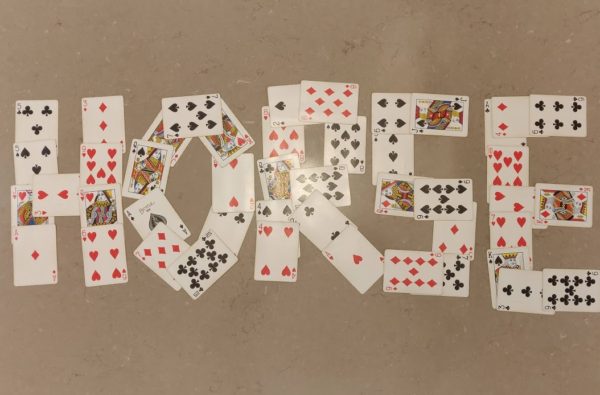
Three of the games in H.O.R.S.E. are Stud variants, which means a lot of cards are going to be exposed during a hand. As such, memorization is essential for playing successful Stud. Up to six cards may be folded once a hand progresses to Fourth Street, and these outs may become important later in the hand.
For example, on Third Street you see two kings fold, and you have a king in the hole. If your opponent is showing Q-A-10 on Fifth Street, you know they are drawing thin to Broadway. You’ll be more likely to call them down with two pair or a weaker straight on later streets than you would if you don’t remember that three kings are dead to their hand.
Another common example is when you see three players with a king on Third Street, and a player out of position completes. While it is possible they are an aggressive player trying to push the other kings out; it is also possible they are raising with a pair of kings or another buried pair. They’ve effectively telegraphed their hand, and anyone calling the bet knows that they cannot improve their pair of kings.
If you have a problem with memorizing cards, work on improving that skill immediately. It is one of the most crucial basic skills needed in Stud and one you will use 60% of the time you’re playing H.O.R.S.E.
Some NL Hold’em players love to adopt a looser style of play where they play more hands than the average opponent. This works great for NL but is a strategy that will drain your stack in many H.O.R.S.E. games. The five H.O.R.S.E. variants are played in a Limit format. You cannot get your entire stack in and recover from an hour’s worth of bad play in a single hand.
READ MORE: H.O.R.S.E.-ing around at the 2006 WSOP
You’re going to need to exercise more patience in Limit games, meaning that you’re looking to come in with strong holdings. When appropriate, you will adjust depending on your position and game dynamics, but you are going to play fewer speculative hands in H.O.R.S.E. than you will in NL Hold’em.
It is my personal belief that if you can play Seven Card Stud efficiently, then you have the patience to play any form of poker. Stud requires much more patience than other forms of poker. Combine that with the speed of the game, and waiting for better hands in Limit Hold’em or Omaha Hi-Lo won’t seem like such a chore.
When playing H.O.R.S.E., strong board play is important in Stud games. Each hand, your opponents will be able to see up to 57% of your hand. On each street, they are going to be looking to place you on hands. As the hand develops, the ability to represent a strong hand is important to pushing players off pots.
Razz is perhaps the best example of where strong board play will win you more bets. For a player with a 7 completes and you call with an 8. They then catch a king and you a 7. On Fifth Street, you catch a 2, and they catch a 10. Their best hand presently is a king with 10 redraw. On your end, your best hand is an 8 with a redraw to a seven. At least that is if you’re looking at the board.
It doesn’t matter that you called with 7 and 2 in the hole and now have two pair. A bet on Fifth Street is going to indicate that you’ve got the 8, or at least have a draw to it. Your opponent still has to catch to improve – to a 10. Your bet is likely going to win.
Strong board play on Fourth and Fifth Streets in Stud games is going to help you take down more pots before showdown. Always look for logical spots to represent when playing hands in Stud games.
An important element of all games in H.O.R.S.E. is hand evaluation. Beginning with your starting hand and moving through every street, you have to always consider whether your hand is worth playing. With this being Limit poker, making the right choice when to play or abandon a hand is more about saving bets when you’re behind than it is about maximizing your winnings.
Stud 8 or Better and Omaha Hi-Lo are the two games where hand evaluation is going to save you the most money. For example, let’s say you have 2c-3h-Qh-Kc on the button in Omaha Hi-Lo. Three players are in the pot, and the flop falls 4c-8c-Kh. You have a weak low draw and a second nut flush draw. How do you continue if there is a bet and raise ahead of you? Unless you like chasing down with the worst of it, this is a spot where you ought to be folding.
In Stud 8, let’s assume you start with a three-card 8 against a King and a deuce. By Fifth Street, you have four cards to your eight, while the 2 has improved to what looks like a 7 low. In this case, you are playing yourself into a likely chop scenario. You have to improve on both remaining streets to win high and are still drawing to a low that’s second best. It’s time to get out the hand and save yourself two big bets.
In this episode of The Bernard Lee Poker Show on the Cardplayer Lifestyle Podcast Family, Bernard Lee interviews 2004 WSOP Main Event and now five-time Heartland Poker Tour (HPT) champion, Greg Raymer. Last month, Greg made history by becoming the first player to win the five HPT Main Events, when he captured the HPT Ameristar East Chicago. Of course, Greg also famously emerged from a field of 2,576 players to capture the 2004 WSOP Main Event bracelet.
| 0:00 | Welcome to The Bernard Lee Poker Show as this week’s guest will be the 2004 WSOP Main Event champion, Greg Raymer. |
| 0:13 | Isaac Kempton captured the WSOP Circuit Main Event at the Seminole Hard Rock in Tampa, Florida. The 22-year old outlasting a field of 1,162 entries and taking home $290,974. |
| 1:35 | The RunGood Poker Series has an event in California for the first time at the Jamul Casino in the San Diego area. |
| 3:31 | RunGood Gear Ad |
| 4:15 | Bernard welcomes Greg Raymer to the show. |
| 5:14 | Greg joins the show. |
| 5:36 | Greg reminisces about capturing the 2004 WSOP Main Event 16 years ago. and discusses the famous fossil card protector. |
| 9:00 | Greg discusses the background story of his holographic glasses and why he wore them. Now, he wears Blue Shark Optics sunglasses. |
| 15:28 | Greg discusses the unique Day 1 WSOP Main Event “bubble” including players contemplating folding every hand on Day 1. |
| 20:28 | Greg remembers his 2012 HPT Player of the Year run, where he almost didn’t play the first HPT Main Event that he won. |
| 32:20 | Share My Pair Ad |
| 32:52 | Bernard continues his interview with 2004 WSOP Main Event and now five-time HPT champion, Greg Raymer. |
| 33:41 | Greg remembers his recent HPT Ameristar East Chicago victory, earning $171,411. |
| 36:19 | Greg discusses his Hendon Mob analysis of his final table opponents and how to interpret his analysis. |
| 44:02 | Greg compliments his heads-up opponent, Evan Bethyo, who he felt played well. |
| 48:47 | Greg talks about his schedule and plans, but states that it is not booked out very far in advance. |

Greg Raymer, Bernard Lee, and Chris Moneymaker
Table and card games have been around for centuries and despite their age, they are among the most popular casino games to date. According to some sources, poker itself dates back to 1829 and was only discovered when English actor Joseph Cowell started to spread the news on how to play. We’ve come a long way since the original 20-card deck was used, but the way you win has remained the same.
Thanks to technology, poker and casino aficionados no longer find themselves having to get dressed to the nines (or at all!) to play at a local casino. Instead, they can play from the comfort and convenience of their own home. You can find plenty of information and places to play online without stepping foot outside your front door.
Of course, poker players tend to love a good gamble, thus their interests also extend to other card games beyond poker itself. A such, we’ll take a look below at five of the most popular card games for poker lovers to enjoy.
This exciting variant of blackjack delivers many twists which could see you cashing out a huge sum. The object of the pontoon is to collect cards with a face value higher than the banker’s. However, just like blackjack, you must not exceed 21. Played with a minimum of five and maximum of eight players, simply get as close to 21 as you possibly can without going over. Picture cards (face cards) are worth 10 points, aces are worth 11 or 1, and all remaining cards are worth their numerical value. Hands ranked best to ‘bust’ are as follows:
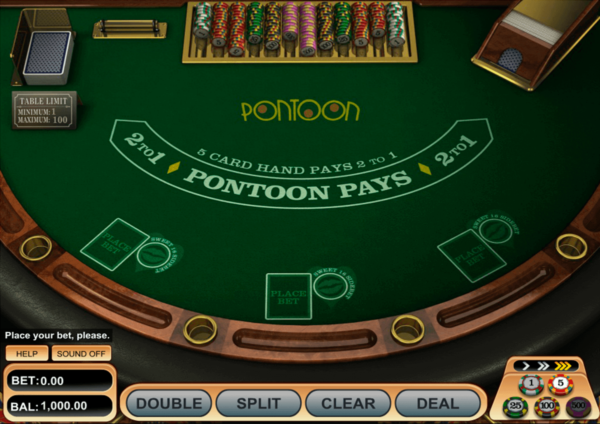
One of the most popular card games of all time is blackjack. The rules are simple; reach 21 and beat the dealer without busting. Unlike pontoon, this is played just a singular player against the house. Each player and the banker are dealt two cards to begin with. You can either stand, which ends your turn, hit to take another card, double down to take another card and double your stake, or split; separating your two cards into two hands. Simple, yet entertaining.
Also known as punto banco, baccarat is a renowned high stakes game and, as such, can often be found away from the main casino floor space. The simple card game sees you either backing the punter or the dealer – just who has the best hand? The goal is to get as close to 9 as possible. The cards 2 to 9 carry their face value whilst picture cards are 0 and Aces hold a value of 1. An even money return comes on correct predictions, or for increased odds of 8:1, you can place bets on a tie.
Pai gow poker is a US take on the popular Asian tile game, created by Sam Torosian in 1985. Like the majority of table games, players must place their bets on the table before the game begins. After all bets are placed, each player and the dealer receive seven cards. Now, you must arrange your cards into two poker hands; one made of five cards – this is known as the big/high hand – and the other made of two – the small/low hand. The 5-card hand must outrank the smaller hand. If both hands are better than the dealer’s, you receive odds of 1:1.
This very simple and fast paced card game is based on a guess. It has nothing to do with the Crouching Tiger, Hidden Dragon movie! The objective in Dragon Tiger is to predict whether the dragon or the tiger will draw the higher value card. To make things a little more exciting, players can also bet on whether the dragon or tiger cards dealt will be of the same value – this one delivers a tie. The rules:
With the wealth of new ways to play poker online and the fact that internet poker rooms are so much better today than they were many years ago, it’s easy to say that poker has evolved since before the poker boom.
Many attest to the fact that the internet has changed the way we play the game, in terms of strategy and technique. But is this true? If you look back at some of the most successful poker players of all time, they possessed a lot of the skills that are touted as being so important in the modern game – and worked on honing them really hard, too.
Before the poker boom and before poker became one of the most-played card games on the planet, many people’s perception of it was that the primary skills required were the ability to bluff and to spot bluffs. The cult poker film, Rounders, helped support this, as Matt Damon portrayed a character (Mike McDermott) who had a unique and incredible ability to deduce what the other players were holding.
Anyone who has played poker online will know that in this setting, it is impossible to read players’ expressions in the same way Damon’s character does in the film. Instead, there is a much heavier focus on mathematical ability and playing with probabilities in mind. This is regarded as a modern poker strategy, and a number of internet players are finding great success in live games by using it.
The thing is, however, that having these attributes has always been key in Texas Hold’em. One of the greatest players of all time, Stu Ungar, was known for having a strong calculating brain which he put to good use in blackjack and gin rummy, along with poker. In fact, many 21st-century poker players turn to playing blackjack games online as a way to improve their overall skillset, but it was the three-time World Series of Poker Main Event champion who did it first.
It could be argued that internet poker has simply made more players aware of the importance of mathematical ability in the game. Because of this, those who are serious about winning online have had to evolve and adapt their game to be able to deal with this type of modern player who is constantly calculating his chances of winning. Many players sign up to poker training sites to help improve their overall game. Certain concepts, such as the stone cold bluff from yesteryear, are virtually nonexistent in professional circles in 2020. Instead, players tend to assess their outs and pot odds before making an attempt to take down a pot with a weak hand.
Of course, in live poker, the concept of reading the opponents’ psychological cues – including microexpressions – is still a major part of the game. When weaker players come up against the best in the business, they often give away tells without realising it. The seasoned pros have spent years picking up on the slightest twitch, and are able to hone in on it.
Poker has evolved in its entirety because a greater number of players are aware of the skills needed to gain mastery of it. However, looking back at some of the greatest names in poker history, they also placed a lot of emphasis on mathematical ability in their strategy. So, we’d say that the answer to our question is “yes, but also no”.
If we look back at all the changes in the online casino industry over the last decade or so, it’s arguable that the live dealer technology is the most important advancement bar none. It really took hold around the middle of the 2010s, and now every (good) online casino provides you with the chance to play poker, blackjack, and roulette with real dealers.
However, and this might seem like a controversial take to those who love live dealer games as they are, there is also a perception that this new genre of casino games has yet to find its feet. Make no mistake, the games are fantastic, popular and it is perhaps underappreciated just how cool the technology is that brings those games to your device. But there is also a sense that they can go further and really capture the imagination of players.
The reason we can make such a bold claim is that it is also apparent to the creators of those games, and you can see how new releases of live dealer games are ripping up the script somewhat. A typical example is Quantum Blackjack Live and Quantum Roulette Live, which are new games you can see at the site of a top online casino operator like casino.com. Below we are going to discuss Quantum Blackjack, and theorise whether the model could be used for poker games.
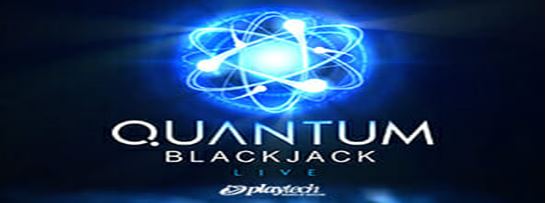
Quantum Blackjack is a new variant of blackjack that fuses a real card game with RNG technology to provide bigger prizes. In a nutshell, the blackjack game plays out as normal, but there is the extra incentive – the “quantum” part. As the blackjack hand is played out, on the side of the screen three other cards are dealt (from a virtual deck).
Each card has a multiplier assigned to it (X2, X3, X5, X10), and if your real hand matches any of the cards from the virtual deck, your win will be multiplied by that amount. If you were to match more than one card, the multipliers are multiplied in an accumulator fashion. So, it’s possible to receive 1000 times your stake for a winning blackjack hand, i.e., matching three cards each with a 10X multiplier.
So, how is Playtech able to create such a game, given that we know blackjack has a really low house edge? Well, the trade-off is that the dealer pushes when they bust with three cards, so that evens up the score in favour of the house.
The pertinent question, then: Would such a model work for casino poker games? It’s a difficult one to answer. One could argue that the reason this has been such a big hit for blackjack fans is due to the fact blackjack has relatively low payout rates, e.g. 1:1 for a winning hand and 3:2 (but not in all variants and casinos) for a winning blackjack hand.
Obviously, many poker games don’t need such an incentive, because the payouts can already be many times greater your stake. However, there are exceptions, including three-card poker at online casinos. The game has a similar payout structure to blackjack, paying even money for a winning hand. Yes, there are side bets where you can usually win 100:1. But that requires placing an extra bet, whereas the “quantum” payouts are built into the main game.
We could easily see a developer like Playtech release a quantum version of three-card poker sometime soon. However, the exciting bit here is the fusion of live gaming and virtual technology. It points to many exciting possibilities for live dealer casino games in the future, including online poker games.